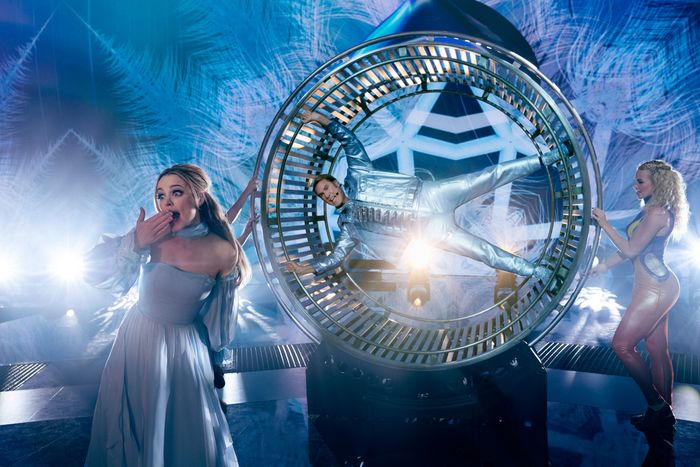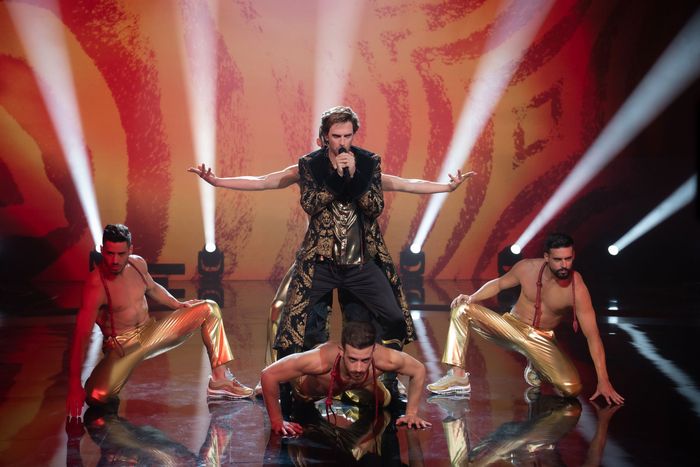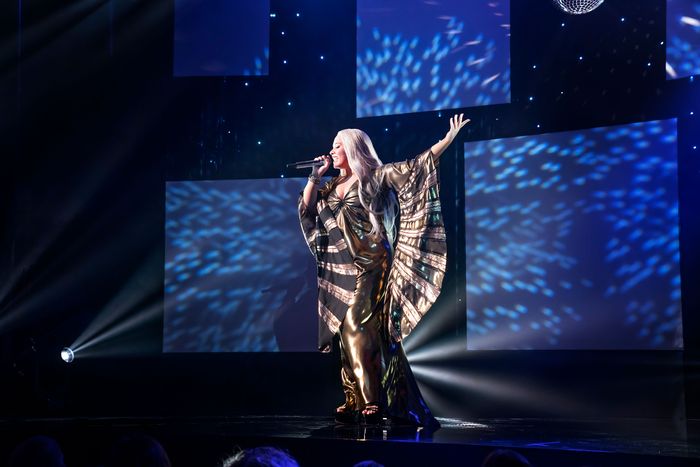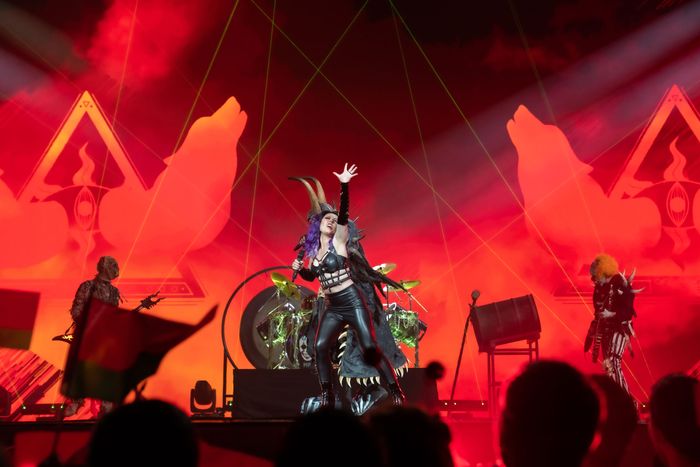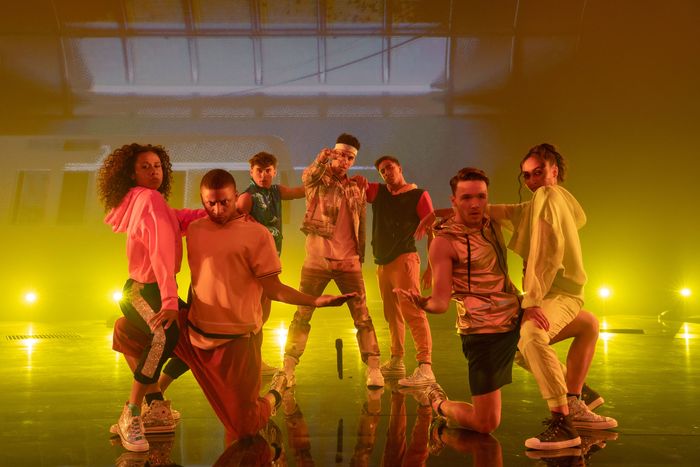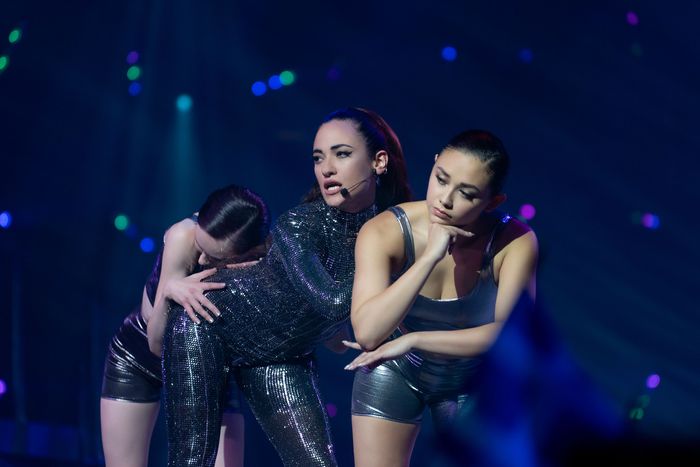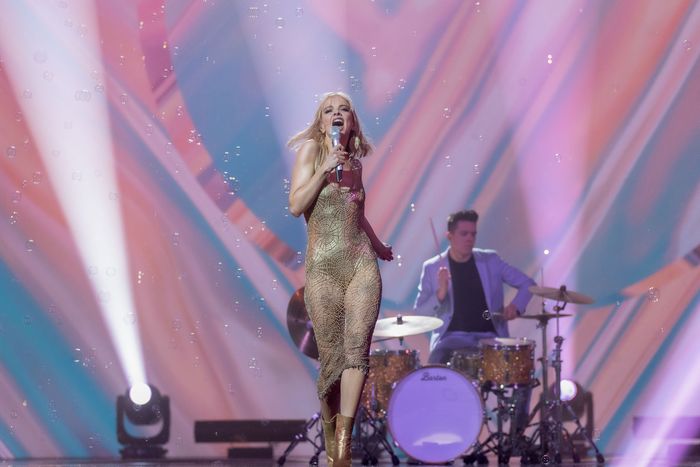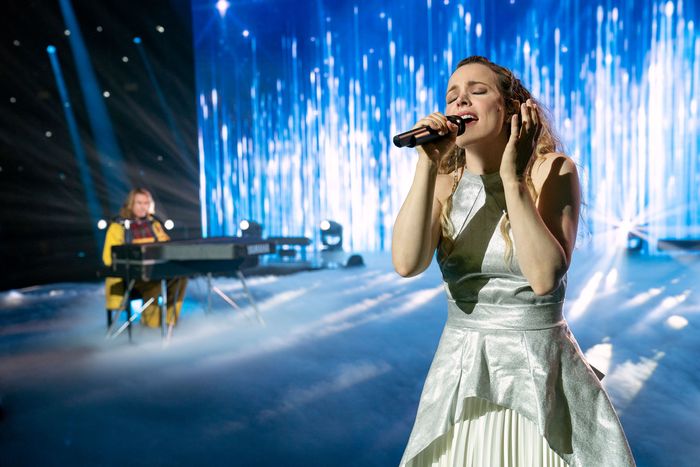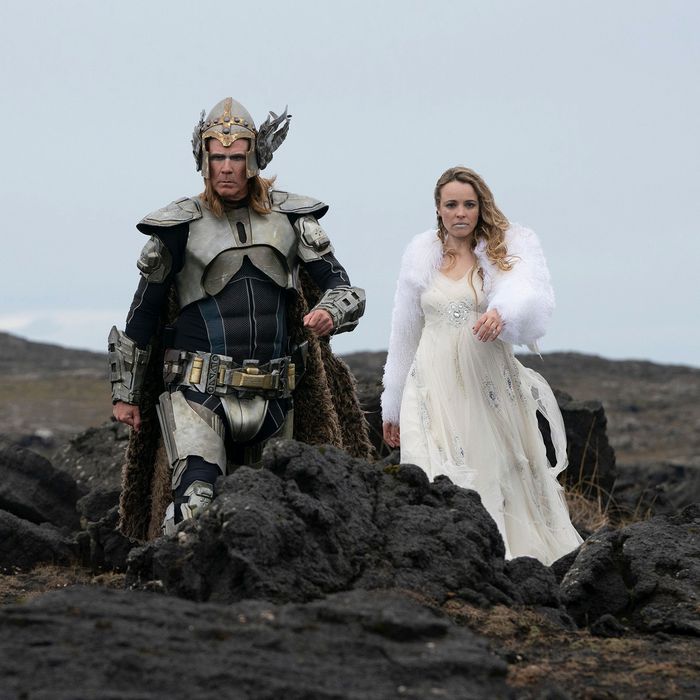
Every year since 1956, usually in May, the nations of Europe have gathered to determine which of them has the most exuberantly kitschy, delightfully overproduced infectious pop song. In 2019, 41 countries competed, including Azerbaijan, Russia, and even Australia, and around 180 million viewers watched the televised contest, even though most Americans don’t know much about it. Eurovision Song Contest: The Story of Fire Saga, starring Will Ferrell and Rachel McAdams as a hapless Icelandic singing duo, was supposed to open theatrically in late May to coincide with the actual event. But with Eurovision itself canceled, Eurovision the movie not only has to stand on its own (on Netflix); it might just have to stand in for the real thing, because the music — ridiculous and catchy in equal measure — is arguably just as good as much of what Eurovision presents anyway.
“I didn’t want Dick in a Box, but we’re also not making A Star Is Born here,” says director David Dobkin, who, besides having directed Wedding Crashers, is also a music-video veteran. He envisioned the film’s songs walking the fine line between satire and homage. “It’s okay if it’s funny, but it has to be really good music. It has to still be great and just kitschy enough to be Eurovision, because that’s part of what’s fun about Eurovision.” (Besides, nobody pokes fun at Eurovision better than Eurovision itself.)
For Ferrell, who says he was first introduced to Eurovision more than 20 years ago thanks to his Swedish wife, the film served as something of a love letter to the event. “My first experience watching Eurovision, I got sucked into it even more because Sweden happened to win that year. So I’ve just always been smitten with it.”
To produce the soundtrack, the filmmakers enlisted Savan Kotecha, who has written and produced pop hits for the likes of Ariana Grande, Katy Perry, and Ellie Goulding. “Serious songwriters in the big pop-music world kind of make fun of things like Eurovision,” Kotecha says. “But when you have to do it, you realize it’s actually a craft in itself.” To help with the process, Kotecha assembled other writers — some newcomers, some legends, nearly all Scandinavian. For the choreography, the filmmakers hired Tabitha and Napoleon D’umo, veterans of So You Think You Can Dance and American Idol.
Here, the songs created for Eurovision Song Contest: The Story of Fire Saga and the stories of how they came together. (There are some spoilers for the film.)
Volcano Man
Fire Saga (Iceland)
Played by: Will Ferrell, Rachel McAdams
Actually sung by: Will Ferrell, Molly Sandén (a.k.a. My Marianne), Rachel McAdams
The music video that introduces Fire Saga in the film, complete with Ferrell’s Lars stomping around a volcanic wasteland wearing armor, was shot at a real volcanic lava field near Keflavik. (“It’s about to erupt again, apparently,” says Dobkin.)
Behind the music: “Remember that episode of Friends where Ross thinks he’s a musician, and he’s playing the keyboard, and he really just takes himself super-seriously?” asks Kotecha, who says he gave that reference point to Gustaf Holter and Christian Persson, the up-and-coming Swedish writing-and-composing duo who created “Volcano Man.” He also suggested they think of Ferrell “just doing something like ‘Huh huh huh huh huh,’ ” to start the song, referring to Lars’s rhythmic chanting that opens the piece. “And they just came up with ‘Volcano Man’!” Holter and Persson imagined the song as something from “a bad superhero film.” Or as Persson puts it, “It’s like a German child’s idea of something really amazing.”
While recording the song, Ferrell needed some time to find the right balance between satire and tribute. “It was feeling a little bit without personality,” he recalls. “I started messing around with it, singing a little more with Lars’s intonation. That ten-degrees difference just made it come to life.” Dobkin points to how Lars “opens the ‘ah’ in ‘mahn’” when he sings the words “Volcano Man” as an example of the song’s comic effect. “Will knows exactly how far to bend the comedy of it.”
Double Trouble
Fire Saga (Iceland)
Played by: Will Ferrell, Rachel McAdams
Actually sung by: Will Ferrell, Molly Sandén (a.k.a. My Marianne), Rachel McAdams
The tune Fire Saga performs at Eurovision, it opens with dreamy, folksy lyrics sung by Sigrit Ericksdottir (McAdams) followed by an abrupt, Andrew Lloyd Webber–esque reverie from Lars, before settling into a grand, highly melodic chorus.
Behind the music: Ferrell remembers crying when he first heard the demo of “Double Trouble.” “I was laughing to hide the tears because I couldn’t believe how perfect it was,” he says. The piece actually served as a kind of audition for Kotecha, who says that the song was created quickly. “One of my close friends Arnþór Birgisson, is Icelandic. Me, him, and Rami Yacoub actually had a bunch of hits together like eight years ago. But I moved to L.A., Arnþór became a private pilot, and we hadn’t been in the same room together writing a song for a while. He was about to fly in, and Rami was there, and I was like, ‘No pressure. Let’s just have some fun and try to come up with something.’ I told Arnþór, ‘Let’s try to make it feel like an Icelandic folk song in the start and then we’ll do a big chorus melody. We wanted to make sure it felt like a big melody and with lyrics that almost felt they were Google Translated from another language back to English.” Once Dobkin heard the song, he asked Kotecha to produce the film’s entire soundtrack. Kotecha also discovered that Swedish singer Molly Sandén was in town and had her record a demo of the song as Sigrit. Sandén, who once placed third in the Junior Eurovision Song Contest in 2006 (Sweden’s best result to date in that particular competition), wound up singing on Fire Saga’s songs, but the music team also recorded McAdams in order to blend her voice with Sandén’s. “It was lightning,” Kotecha says, noting that there were some parts of the song where they couldn’t tell whose voice it was.
The big live performance of “Double Trouble” at Eurovision in the movie was an opportunity to go over the top and add more comic flourishes. “Lars is misguided; he wants to be the act with the biggest bells and whistles,” says production designer Paul Inglis, who had to help create fire effects, loads of rear projection, and a giant hamster wheel for Lars, a prop inspired by Ukrainian singer Mariya Yaremchuk’s infamous performance at the 2014 Eurovison contest. “We just kept thinking, ‘Well, we need to have some kind of piece of staging that is incongruous to the song and is just kind of flashy,’” says Ferrell. “And we couldn’t think of anything better. ‘Should we just do the hamster wheel?’” The actor says he was later reminded constantly by the film’s prop team about “how much work they had to put into this massive steel hamster wheel with like 96 weld points, as I was sitting up there a hundred feet in the air going, ‘Uh-oh, why did I agree to do this?’”
The performance required some savvy choreography as well, since it also furthers the lead characters’ relationship. “Rachel was trying to feel a little uncomfortable in her skin, and she wanted it to be obvious,” says Tabitha D’umo. “So we had a little exploration of how her character would naturally move versus feeling choreographed, but then she had to break that for the moment they were in sync together.”
Lion of Love
Lemtov (Russia)
Played by: Dan Stevens
Actually sung by: Erik Mjönes
Cocky Russian pop star Lemtov, played by Dan Stevens, operatically charges his way through a techno-safari extravaganza about a lion on the hunt for love on the savanna, performed with male dancers, whips, and gold lamé.
Behind the music: “Lemtov is this in-the-closet Russian who acts overly macho, and ‘a lion of love’ — that line just felt right,” says Kotecha, who co-wrote the song with Swedish collaborators Rami Yacoub and Johan Carlsson. The song itself took a while, however, “It just didn’t have the big enough campy melody,” he admits. After Dobkin told them that he wanted “Lemtov to be able to sing,” however, something clicked. Once they imagined the song opening with a big operative bellow from the singer, it began to take shape. “It was all about thinking about the performance and just having a fun time with the lyrics, taking the lion of love metaphor and running with it,” says Kotecha. “We were just laughing to ourselves. No one would know this, but the line ‘Someone somewhere tonight will meet the lion of love,’ we spelled it like M-E-A-T on the lyric sheet.”
“Lemtov is not particularly alien to Eurovision and that sort of pop-operatic style, incredibly bombastic, very sexualized staging,” says Stevens, who says he laughed out loud when he first heard the song. (One stated inspiration for Lemtov: the Russian singer Philipp Kirkorov, who competed at Eurovision 1995. Another possible inspiration: Romania’s 2013 contender, Cezar.) For Lemtov’s highly sexualized moves with his male dancers, Tabitha D’umo wanted to go over the top. “Let’s dance with whips! Let’s tear his shirt off!” she says. “Let’s think things theatrically, and we’ll lean into that and have fun. I had a blast choreographing this. And the actor was not afraid to go there as well.”
The production design embraced a faux–Lion King style, with “jumping gazelles, animal prints, all these things,” says Paul Inglis. “We did wonder whether we’d gone too far.” One of the great challenges for Inglis’s team for many of the songs was creating imagery for the massive, 80-feet wide, 24-feet tall video wall that dominates the Eurovision stage. “Every performance had to have its own imagery that was in time with the music and hit certain beats and have movements within so that when you hit a chorus, it changes and develops,” he says. Doing all that in post was not an option. “None of that was added afterward, because of the sheer effect all that light pumping out has on everything in front of the screen — you can’t say, ‘Someone else will worry about it later.’”
Something else the filmmakers couldn’t really fake: the crowd. Eurovision is performed in massive stadiums, and Dobkin didn’t want to go for Bohemian Rhapsody–style CGI crowds. Instead, the production actually attended the 2019 Eurovision contest in Tel Aviv to get plate shots and footage of the throngs watching the show. “Lion of Love” was one of the two songs that the production played for the crowd at Tel Aviv. “We shot for five nights with three cameras just to get the audience reactions and the crowd,” says Dobkin. “When the rhythm of ‘Lion of Love’ hit, something happened and the crowd got on their feet and started dancing every night that we ran that song.”
In the Mirror
Katiana (Iceland)
Played by: Demi Lovato
Actually sung by: Demi Lovato
A melodic ballad from the immensely talented singer Katiana, who wins the Icelandic Song Contest early in the film, giving her the chance to represent Iceland at Eurovision. Then, of course, something awful happens, and the country is tragically left with Fire Saga as its sole contestants.
Behind the music: “In the Mirror” was written by Jörgen Elofsson, who was responsible for such pop classics as Britney Spears’s “Sometimes” and Kelly Clarkson’s “Stronger,” as well as a number of Westlife hits back in the day. “This was a great opportunity to bring back some writers who I loved growing up,” says Kotecha. “Jörgen was just kind of doing local stuff, but his melodies are so good — they’re such great pop melodies.” Elofsson had originally submitted “In the Mirror” as a potential song for the climactic set piece that would eventually become “Husavik.” “It was very close, and the chorus is great,” says Dobkin, but it didn’t feel quite right for the film’s grand, emotional finale. After the filmmakers had “Husavik” figured out, Kotecha put the piece back in front of the director, and they worked with Elofsson to change the second half of the song. “Lyrically, it’s really this funny song about a girl who’s so self-centered and doesn’t even know it. It’s a wink at being a pop star,” says Dobkin. “And at the same time, when you listen to it, it’s so beautiful. When we were on stage shooting it, Demi was like, ‘I love this song. I think I want to perform it when I go on tour again.’”
Jaja Ding Dong
Fire Saga (Iceland)
Played by: Will Ferrell, Rachel McAdams
Actually sung by: Will Ferrell, Molly Sandén (a.k.a. My Marianne), Rachel McAdams
A goofy Icelandic folk song that Fire Saga is repeatedly, angrily forced to perform in their local pub, the Captain’s Galley, instead of their own beloved disco tunes.
Behind the music: Dobkin says that there were at least three or four writing teams that tried to compose that song. “We were trying to create a bar song that Fire Saga didn’t write, because in the movie, supposedly, this is just a traditional song.” The director had the title in his head, but little else. “We knew it had to be a call-and-response to feel like a pub song,” says Kotecha. “It’s all about that chorus.”
The team that wound up writing the song was the same duo who wrote “Volcano Man,” Gustaf Holter and Christian Persson. “We wanted it to be super-cheesy, but also incredibly catchy at the same time,” says Persson. “’Stupid-catchy,’ we call it.” For the music, they were inspired by Dutch folksongs, which have prominent, slower bass lines around which swirl faster, happier melodies. Persson and Holter also loved the idea of creating crude song lyrics — “My love for you is growing wide and long … I swell and burst when I see what we’ve become” — that could be performed in a guileless, cheerful way, as if the singers didn’t really understand what they were saying. The results are weirdly irresistible. “I played it one time in my house — one time! — and my 11-year-old and 8-year-old were singing it for weeks,” says Dobkin. Kotecha says that people genuinely mistake it for a traditional song now. “I’ve had a few people tell me, ‘That’s like an Icelandic pub song or something?’ Like, nope! That’s a new song.’”
Running With the Wolves
Moon Fang (Belarus)
Played by: Aiste Gramantaite, Liam Clarke
Actually sung by: Courtney Jenae, Adam Grahn
A metal band with heavily made-up prosthetics — including a zombie-clown guitarist and an orclike lead singer — whose growly sound still manages to settle into an ’80s Europop beat that would make Modern Talking blush.
Behind the music: In the script, this piece was initially supposed to be “a weird, kind of crazy Dutch version of a rockabilly band,” says Dobkin. “And we tried so many times to create a rockabilly song that would have big pompadour haircuts and stuff. It wasn’t working.” Instead, Kotecha commissioned a heavy-metal disco number from Andreas Carlsson, who wrote “Bye Bye Bye” and “I Want It That Way.” “Andreas is the biggest KISS fan on the planet,” says Kotecha, “and he’s so good with those melodies. He gets a little musical theater in there.” The result also served as a tribute to Lordi, the Finnish heavy-metal band that won Eurovision in 2006 with “Hard Rock Hallelujah.” “This was one of the more fun pieces to do for me, because of the Lordi-meets-Slipknot approach,” Inglis says proudly. “The guitar lights up and looks like it’s made of volcanic lava. We created beer kegs that could be bashed for percussion. For the backing visuals, we ran slightly cliché, but we didn’t want to look too much like a 1980s Venom album cover.”
Coolin’ With Da Homies
Johnny John John (Sweden)
Played by: Christopher Jeffers
Actually sung by: Savan Kotecha
A hip-hop entry from Sweden with lyrics like “Volcanos on my chest / Just like I’m Kim West / I don’t need silicone to show / Rappers I’m the best.”
Behind the music: “My experience living in Sweden in the early aughts, the local rappers would rap in English in two-year-old slang,” says Kotecha (who insists that nowadays Sweden has far better, up-to-date rappers). “Me and Rami talked about making the track a little bit like [the Finnish hip-hop group] Bomfunk MC’s.” Kotecha then started freestyling himself and came up with some of the rap’s lyrics: “They say that I talk too fast/ Idon’treallytalktoofast / Idon’tthinkItalktoofast / Idon’tthinkItalktootalktootalktoo-fast.” For the choreography, Tabitha D’umo opted to keep the dancing on point. “We wanted to make it feel as current as possible,” she says. “That style of dance and movement sometimes you can’t fake.”
Come and Play
Mita (Greece)
Played by: Melissanthi Mahut
Actually sung by: Petra Nielsen
Greek performer Mita’s pop-cabaret number with sci-fi staging, skintight outfits, and thrusting ballerinas.
Behind the music: “Mita became a bigger and bigger character as we developed the script,” says Dobkin. Kotecha commissioned the song from Thomas G:son, a writer whose pieces have reached Eurovision 13 times and who won in 2012 with the Swedish entry “Euphoria.” “She’s so sexy and open and aggressive. It was like she represented this other side of the world that these two innocent people had never been in.” (Spoiler alert: She seduces Lars.) Mita’s performance involves giant floating jellyfish, dancers with huge bubbles on their heads, and Avatar-like projections. “David was like, ‘I want her to come out of the ground and she’s in a spacesuit!’ ” recalls Tabitha D’umo, who found inspiration in a Vegas specialty act “with this girl who would get inside a balloon and do this risqué burlesque act. I said, ‘How can I be sexual and sensual in space?’” The choreographer decided to present Mita as “the ringmaster of this space world … She would travel to a different part of the stage and have moments in these little tableaux, one with a ballet dancer, another with this guy who could do these bone-breaking dance moves.” D’umo also presented Dobkin with some proposed shots in which the ballet dancer would creep through Mita’s legs, sweep them apart, and then do “two thrusts from the ground with a low angle right beneath her pelvis.” What she calls “the money shot” is in the movie.
Fool Moon
The Wonderfour (Finland)
Played by: Anteros (Laura Hayden, Joshua Rumble, Jackson Couzens, Harry Balazs)
Actually sung by: Anteros
The Britpoppy-sounding entry from Finland.
Behind the music: This was a song the filmmakers did not have to create from scratch. “I heard that song when we had reached a point where we could not produce anymore original music,” says Dobkin. “That song is that band’s original song. Becky [Bentham], who is our amazing music supervisor on the movie, brought it to me, and I thought it was great.” Still, Dobkin and team did give the piece some Eurovision-y oomph. “We added a little bit of music to it. During the choruses, we did our own little twist on it with the theremin.” The band even got to play themselves in the film. “The whole band and their look was great,” says Dobkin. “I saw their video and I’m like, ‘Let’s just do that. That’s so good.’”
Hit My Itch
Dalibor Jinsky (San Marino)
Played by: Junior Delius
Actually sung by: Antonio Sol, David Loucks, Taylor Lindersmith, Nicole Leonti
An R&B-inflected pop song from the somewhat unlikely microstate of San Marino, a nation stuck inside Italy.
Behind the music: “There’s a group called Matter Music in the Valley — Ric Markmann, Danny Pinnella, Chris Wagner — who have been doing music for my movies in one way or another and all my commercials for the last 20 years,” says Dobkin. “They’re these three amazing studio musicians and touring musicians. They were competing for the ‘Double Trouble’ spot. They sent in that song, and we loved it so much — it’s a true hidden gem. When ‘Double Trouble’ ended up winning the bake-off for that spot, I begged them to let me use that song in the movie, and that became Dalibor Jinsky’s song.” For the production design, Inglis went with the idea of falling petals to match the soulful performance with a muted background and chrome microphones. “This is where the more simple approach is best,” he says, noting that with so many different songs being performed, it was important to have some variation — they couldn’t all be kitsch.
But why San Marino? When the filmmakers traveled to Eurovision 2019 in Tel Aviv, they were surprised to see San Marino represented by a 50-something Turkish singer and game-show host named Serhat — which seemed like a complete non sequitur. So why not a teary-eyed R&B crooner this time?
Husavik
Fire Saga (Iceland)
Played by: Will Ferrell, Rachel McAdams
Actually sung by: Will Ferrell, Molly Sandén (a.k.a. My Marianne), Rachel McAdams
The film’s emotional climax. Up onstage to perform in the finals, Lars tells Sigrit to sing the very personal, solo song that she’s been working on throughout the film, instead of their more poppy (and heretofore disastrous) “Double Trouble.”
Behind the music: “I have to give a lot of the credit to the co-writers Fatmax [Gsus] and Rickard Göransson,” says Kotecha, “because they were in another room while I was working on ‘Lion of Love.’” Kotecha had called friends in Sweden and others who had written for Eurovision and given them assignments. “This was the hardest nut to crack,” he says. “I had them try to come up with ideas, because this one wasn’t necessarily clear [in advance]. It could change the story if you get it right; it adds so much heart to the story. They came and they presented this rough melody with some of the lyrics, and we talked about the themes of the lyrics, and about what the characters are kind of going through, because this one is personal for Rachel’s character. You have to see the movie, but it ties their relationship together.” As the songwriters went back and forth revising the song, they began to try some Icelandic and “a lot of Google translating,” says Kotecha.
Of all the songs in the film, “Husavik” is the one Dobkin is most proud of. “The number of bars — dropping the pre-chorus on the second verse, all of it was just an incredible piece of construction. The way that works in the movie is what you as a filmmaker hope for,” he says. “Savan and I went back and forth over dozens of versions of the same song, reworking it — what should be in Icelandic, what should not, when does it come in. It needed to work for the movie in a very specific way in my head.”
Though the final song combines the vocals of Rachel McAdams and Molly Sandén, we do hear the actress herself singing “Husavik” solo earlier in the film, when she’s alone in her room composing the song. Crucial to the climactic performance’s effect, however, was when Ferrell’s voice comes in, as the actor’s voice already carries comic overtones; Lars is supposed to be supportive and muted in this scene, and it would not have made sense for him to barge in, Will Ferrell style, and elicit laughs in the middle of this highly emotional scene. “We’re playing the scene very earnestly and very straight, because the movie gets you there,” says Dobkin. “And his backup vocals are beautiful in that song, actually. And his harmonies, which he writes, are great.”
For production design, “Husavik” presented a different challenge, since the song is, narratively speaking, unplanned for — Lars prompts Sigrit to sing it at the last moment, in place of their final performance of “Double Trouble” — and yet it still had to work cinematically with the video wall behind McAdams and the lighting on the stage. “For that performance to happen against a completely dark screen would be very jarring,” says Inglis. “So, we took a bit of a liberty and we almost made it look to begin with a bit of stock imagery that had already been used [for “Double Trouble”]. Then, as the song builds, you can get away with more. Because it’s a slightly fantastical thing that’s happening anyway. The same goes for the lighting cues: They start very simply as a straightforward program from another song is being used. Then, as the song builds, the lighting gets more passionate and enthusiastic to fit the material. Finishing with this lovely foil drop explosion at the end.”
The Song-Along
Performed by: John Lundvik, Anna Odobescu, Bilal Hassani, Loreen, Jessy Matador, Petra Nielsen, Will Ferrell, Jamala, Erik Mjönes, Molly Sandén, Elina Nechayeva, Conchita Wurst, Netta, Alana Da Fonseca, Alexander Rybak
At a blowout party in one of Lemtov’s many homes, the cast and past Eurovision winners and contestants join in on an elaborate mash-up medley of Cher’s “Believe,” Madonna’s “Ray of Light,” Celine Dion’s “Ne Partez pas Sans Moi,” the Black-Eyed Peas’ “I Gotta Feeling,” and ABBA’s “Waterloo.”
Behind the Music: The song-along sequence had been written into Will Ferrell and Andrew Steele’s script with a note about possibly trying to get former contestants to also participate. Dobkin initially thought of getting past Eurovision winners ABBA and Céline Dion to perform their own songs, though they declined. (He notes that he got farther with Dion than he did with ABBA.) Though the sequence might recall a similar scene from the movie Pitch Perfect, Dobkin was thinking more along the lines of the popular mash-up of Linkin Park and Jay-Z’s “Numb/Encore.” “When you hear that version of those songs, you actually have a hard time pulling apart what’s what and what used to exist where. I wanted a mash-up and a remix dance version of something that you could put in fucking dance club and everybody would love.” He says his wife suggested using Cher’s “Believe,” which became the backbone to the medley.
Again, however, it took a while to get it right. “A bunch of people took a swing at this thing,” Dobkin says. “And I was feeling like I wasn’t expressing what I wanted. It was supposed to be easy. All these versions that were coming up were too complicated.” To help realize the medley, Netflix director of music Amy Dunning connected the director with musician and producer Alana Da Fonseca, who Dobkin says ultimately put together a track for him in 30 minutes that was nearly perfect. “I walked out of there with it on my phone, played it in my car, called her up, and said, ‘This section is too long.’ By the time I got home, she had edited it and it’s what you hear in the movie.” Producing the actual song, of course, was a nightmare. “There are so many people from so many different countries, and getting each of them in the recording studio and succeeding at that was a whole other thing!” says Dobkin. The final track includes performances from past Eurovision stars like Sweden’s Loreen and John Lundvik, Austria’s Conchita Wurst, Ukraine’s Jamala, Belarusian-Norwegian disco-violin superstar Alexander Rybak, and Israel’s Netta, all accompanying Ferrell, McAdams, Mahut, and Stevens’s characters.
For the actual scene in the film, the production shot at Knebworth House, a Tudor Gothic mansion in Hertfordshire, England. “Okay, if you’re a fabulously wealthy Russian who wanted to throw an amazing party, what would you do?” says Inglis. “Lemtov can basically have anything he wants materially, even though obviously he can’t have everything he wants emotionally. It was an expression of flamboyance.” So, production added gold-plated supercars, ice sculptures, naked statues of Lemtov, trampolines, marble, and disco balls. “It was a good challenge because it’s tricky to put that many different elements into an existing space, which already has a lot of detail and to have it not just become a mess or a jumble,” says Inglis. “Part of the reason we liked Knebworth is that there’s a really good flow from room to room. So it was possible to start something in one room and move it through to another, bring it out to the garden and bring it back in, have it go high up onto the balcony looking down on the main hall and then come back down into that hall to finish off.”
*A version of this article appears in the June 22, 2020, issue of New York Magazine. Subscribe Now!



